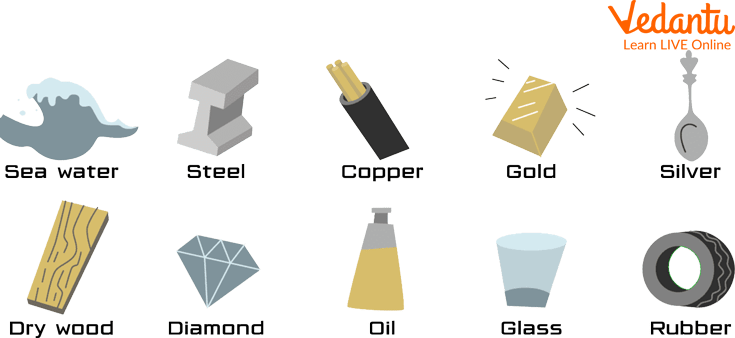




Introduction to Bad Conductors of Electricity
Why is it said not to plug a metal object like a fork into an electric socket? That is because you can get an electric shock, but how and why is that possible? Have you ever wondered why some materials can pass on an electric current to the next object while other materials can’t?
Materials that can easily conduct electricity or material that allow electricity to easily pass through them are known as conductors. Metal is an example of a good conductor. Since metal allows electricity to pass through it easily, when a metal object is plugged into an electric socket, the electricity passes through it, and the person holding the object receives an electrical shock. Wood is one of the poorest conductors of electricity.

Conductors and Insulators
Conductors vs Insulators
Conductors allow electricity to easily pass through them. Substances known as insulators are materials that do not allow electricity to pass through them easily or at all.
Conductors - Metals, water, humans
Insulators - Rubber, wood, plastic
Conductors
How does a conductor allow electricity to flow through it? In materials such as metals, which make one of the best conductors, there is an easy flow of ions and electrons once a voltage is applied. This easy flow of ions from atom to atom allows the metal to conduct electricity.
Conductors have a very low resistance to electric current.
Insulators or Bad Conductors
Atoms in materials such as rubber have tightly bound electrons, which prevent the flow of electricity. Insulators or Bad/Poor conductors, thus, are materials that do not allow free and easy flow of ions and electrons from atom to atom. Most non-metals make bad conductors as this easy flow of ions is not possible. Poor Conductors of electricity have a high resistance to electric current.
Have you ever seen electric wires? These wires are made of metals such as copper, which are great conductors to allow an electric current to flow. But these copper wires are often covered with rubber which is a poor conductor of electricity to prevent anyone from getting an electric shock when they come in contact with the wire.

Rubber Insulated Wires
Why are Covalent Compounds Generally Poor Conductors of Electricity?
Covalent compounds are molecules that are made up of more than one atom pair sharing valence electrons. These compounds have covalent bonds. Examples of such compounds are Oxygen, Nitrogen, etc.
These covalent compounds are bad conductors of electricity as these molecules are made by atoms sharing electrons. Thus, there are no free electrons left to conduct electricity.
Interesting Facts about Insulators
Covalent compounds are bad conductors of electricity.
High temperatures can make good conductors not conduct electricity well.
Dielectrics are insulating materials, which when placed in an electric circuit, have a polarising effect (positive charges move toward the electric field and negative charges move in the opposite direction of the electric field).
Substances that are bad conductors of heat are often bad conductors of electricity also.
Summary
Insulators or bad conductors are materials that do not allow electricity to easily pass through them. Atoms in such material have tightly bound electrons, which prevent the flow of electric current. Examples of bad conductors include - Wood, Rubber, Glass, Sand, etc.
FAQs on Poor Conductors of Electricity
1. Which metal is the poorest conductor of electricity? Which metal is the best conductor of electricity? Why?
Tungsten is the metal that is the poorest conductor of electricity. When the current reaches it, it heats up so much that it starts to glow as it has a very high melting point. This is why it is used in electric bulbs in the form of a coil. The metal that conducts electricity the best is pure silver. However, pure silver is very expensive, and thus copper or aluminium is used in its place. The conduction of electricity depends on the availability of free electrons.
2. What is Electrical Conductivity? Can any environmental factors cause a change in conductivity?
Electrical Conductivity refers to the ability of an object to allow easy flow of an electric current through it.
High temperatures can affect the conductivity of a substance. When the temperature rises, the ions in a metal vibrate faster, which increases its resistance. This causes a decrease in their conductivity. However, for electrolytic conductors, high temperatures increase conductivity.
3. How do conductors work?
A conductor, or electrical conductor, is a substance or material that allows electricity to flow through it. In a conductor, electrical charge carriers, usually electrons or ions, move easily from atom to atom when voltage is applied.









